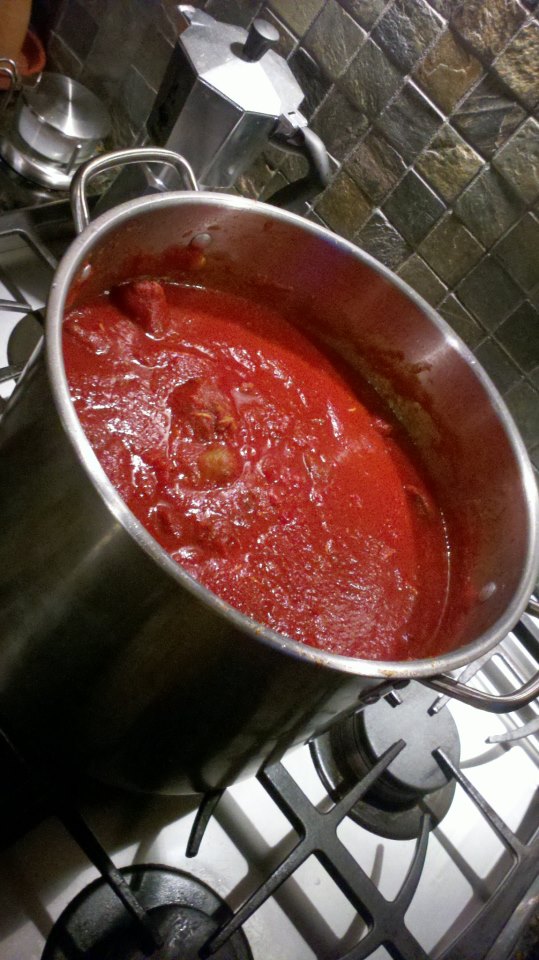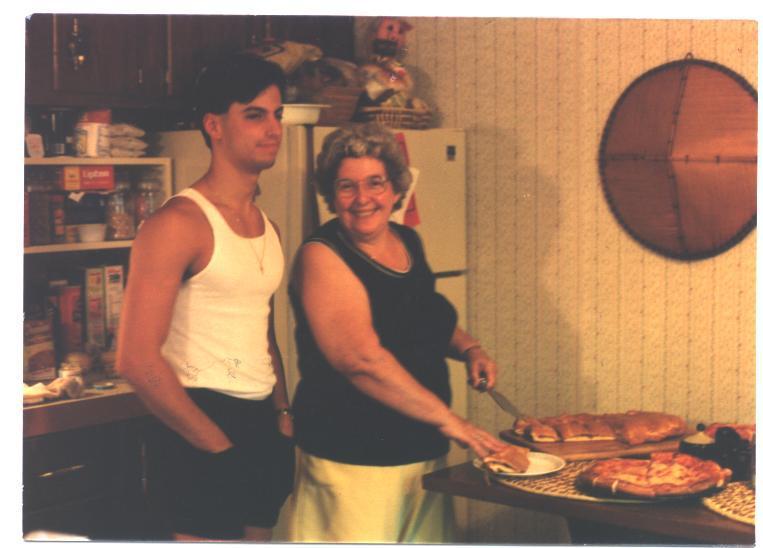My uncle vacationed in Italy a few years ago, and was disappointed with the food. He considered it bland compared to the “Italian” food to which he was accustomed in the US.
I wasn’t surprised by his conclusion. In fact, I think that the reasons behind it are pretty simple. My uncle is Italian-American, and he was eating in the land of Italian-Italians.
Contrary to what many in the US believe, Italian-Italians and Italian-Americans are different beasts. And it’s not just because the latter has a propensity to scratch their crotches in public venues. The differences go right down to the food.
Italian-Italians like their sauces to have clean, fresh flavors. Italian-Americans like them to have intense, meaty (and especially, porky) flavors. Admittedly, I’m generalizing–but this has been my observation.
I’ve eaten in Italy many times, and I never encountered a sauce laden with meatballs, pork ribs, sausage, and beef hunks—in other words, the sauce on which my uncle and I were raised in Utica, NY.
No…nearly every tomato-based sauce that I’ve eaten in Italy tasted mainly of—hold onto your hats—TOMATO!
Sure, you can find sauces with additional flavorings tossed in (e.g., Bolognese with its ground beef, Puttanesca with its capers and spicy peppers, etc.), but these seem to be the exceptions rather than the norm.
So it’s a matter of apples and oranges. Personally, I’d be happy to eat a big bowl of either. But since not everyone is as flexible and open-minded as I am, I feel compelled to provide these folk with some sort of public service.
As such…I list below the recipe for my mother’s (and grandmother’s) classic, meat-heavy, Italian-American “Macaroni Sauce.” “Sunday Gravy,” if you’re from Chicago.
If you are Italian-American, planning a trip to Italy, and fear that your palate might be repulsed by the taste of an unadorned tomato, then you should pack a tub of this sauce in dry ice and wedge it into your suitcase.
Just don’t be scratching your crotch while standing in the TSA line.
OLIVA FAMILY’S MACARONI SAUCE
56 oz. Crushed Tomato
56 oz. Tomato Puree
24 oz. Tomato Paste
Salt & Pepper (to taste)
3-4 cloves of Garlic (crushed with side of knife and skins removed)
Water (no more than 28 oz.)
Olive oil
Red wine for deglazing (if needed)
1 lbs. Italian Sausage (recipe below, or store bought if you have a life outside the kitchen)
1 lbs. Pork “Country Ribs” or Pork Butt
1 lbs. Beef Chuck
1 lbs. Meatballs (recipe below, or store bought if you’re as lazy as I am)
1 lbs. Skirt Steak or Bracciole (optional, but it’s great if you aren’t a cheapskate like me)
Fresh Parsley and/or Basil (chopped)
Step 1: Cut meat and sausage into chunks. Combine meats and garlic cloves in large bowl or hotel pan. Salt, pepper, and toss.
Step 2: In a large sauté pan, fry meats and garlic (in batches) in olive oil at medium-high heat until browned on all sides. Transfer browned batches of all meats and garlic into large kettle (off heat).
Step 3: Add tomato paste to rendered fats and (stirring frequently) fry on medium heat until darkened, but not burned. Transfer fried tomato paste into the kettle with the meat and garlic. If any browned bits cling to the bottom of the sauté pan, then deglaze with red wine, reduce, and transfer to the kettle.
Step 4: Add crushed tomato, tomato puree, and water to kettle. Cook on low heat until the sauce gets hot, then simmer on lowest heat possible. Stir frequently, being very careful not to allow the sauce on the bottom of the pot to scorch or the meatballs to disintegrate.
Step 5: Continue to simmer. Read a book. Hell, write a book. Talk to your spouse. Just don’t forget to stir frequently. Your goal is to babysit that pot of sauce until all the meat to be tender and nearly falling apart. It sounds torturous, but the house will smell so good…you won’t want to leave. Total simmering time (from start to finish) can be anywhere from 8 to 12 hours. As my grandmother would say, “Just taste it.”
Step 6: When sauce is done, stir in the parsley (and/or basil). Top with freshly grated Pecorino Romano or Parmeggiano Reggiano cheese when served. Buy the good Italian stuff, not an ugly step-child from Wisconsin. I also like a good sprinkling of red pepper flakes or a drizzle of chile-infused EVOO, because I am a spicy dude.
Note: If making sauce on the stovetop, my preference is to double this recipe Seriously…if you’re going to trash an entire weekend making sauce, you might as well make a ton and freeze it in batches. It freezes very well, thank god. Also, I place a diffuser under the pot while simmering to lessen the odds of scorching the sauce.
Note 2 and Life-changing #ProTip: Did you know that you can skip 8-12 hours of babysitting a stovetop kettle by making this recipe in a slow cooker? Yeah, it’s true. You don’t even need to stir. I can’t believe it took me this long to think of it. Follow steps 1-4 as described above, BUT…instead of transferring the ingredients to a pot, transfer them to two (2) 6 quart slow cookers (or cut the recipe in half if using only one slow cooker…but seriously, just spend the extra $30 and buy a second slow cooker). Set the slow cooker(s) to “Low,” then come back in 8 hours to finish the job at Step 6.
Note 3: I tried to make this recipe (again, cutting it in half) in an Instant Pot–believing that 8 hours of simmering could be reduced to a mere 20 minutes under high pressure. And it would have worked, if it weren’t for that meddling “Burn” warning. Yes, sadly…the Instant Pot “Burn” function kept triggering before the sauce reached high pressure. If anybody can figure out how to get the sauce to high pressure without triggering “Burn,” you’ll likely find a Nobel Prize under the tree next Christmas. That said, if you have an old school/low-tech stovetop pressure cooker, give it a try and let me know if my hypothesis holds [pasta] water. I’ll betcha it does.
NONNIE’S MEATBALLS
¾ lbs. Ground Beef
¾ lbs. Ground Pork
3-4 slices of Bread (soaked in water and squeezed)
1 Egg
Garlic (minced)
Fresh Parsley
Fresh Basil
Salt & Pepper
¼ cup Grated Cheese
Step 1: Mix ingredients.
Step 2: Roll into balls.
Step 3: Fry in olive oil until browned. Let cool on cooling rack or paper towel-lined plate.
Disclaimer: I haven’t made homemade meatballs in years, much to my mother’s chagrin. It’s just too much trouble. I buy froze meatballs from the grocery store and fry them along with the other meats. Honestly, I can’t tell the difference in the finished product and it saves me at least an hour’s worth of labor.
NONNIE’S ITALIAN SAUSAGE
4 lbs. Coarsely-ground pork butt (i.e., pork shoulder)
2 teaspoons salt
2 tablespoons paprika
2 teaspoons fennel seed
2 tablespoons hot red pepper flakes (optional)
Sausage casings, soaked in water to soften and remove salt (optional)
Step 1. Mix pork and spices in a bowl.
Step 2. Cover and let sit overnight in the fridge.
Step 3. Stuff into casings. How do you do that? Look it up on YouTube.
Another Disclaimer: Steps 1 and 2 are pieces of cake. Step 3 is a bit of a pain. Plus, it requires special equipment. To be honest, I almost always just buy a good quality Italian sausage from the market when making sauce.
BRACCIOLE
1-1.5 lbs. Round Steak (sliced thinly)
Fresh Parsley
Salt & Pepper
Garlic (minced and sautéed) or Garlic Powder
Grated Cheese
Kitchen Twine or Toothpicks
Step 1: Pound steak with mallet.
Step 2: Slice steak into strips (i.e., wider/longer strips for big bracciole; narrower/shorter strips for small bracciole).
Step 3: Sprinkle steak strips with salt, pepper, garlic (or garlic powder), parsley and cheese.
Step 4: Roll strips like a jelly roll, so that the seasonings are inside the roll. Tie with twine or spear with toothpicks, so that they won’t unroll.
Step 5: Fry in olive oil until browned.
Yet Another Disclaimer: I rarely make bracciole. Honestly, the above combo of ribs, chuck, meatballs, and (most importantly) sausage is more than sufficient.























